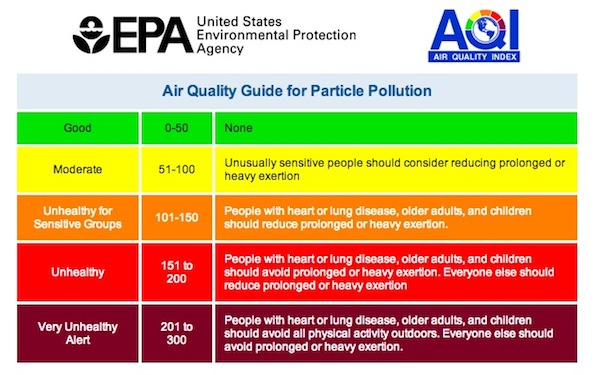What Does the Unbelievably Bad Air Quality in Beijing Do to the Human Body?
The level of soot in Beijing’s air is off the charts, leading to higher risks of lung cancer, heart attacks and other health problems
![]()

The unprecedented levels of fine particulates that pollute Beijing’s air can cause lung cancer, heart attacks and other health problems. Image via Flickr user jaaron
Beijing’s terrible air quality is currently in the news, and for good reason: The level of pollution present in the air there is unprecedented for a heavily populated area, and several times worse than what any U.S. resident has likely ever experienced.
The New York Times recently reported on the air quality problems of Salt Lake City, Utah, and how the area’s geographical features and weather systems occasionally trap pollution in the city’s bowl-shaped basin. But the highest reading on the EPA’s Air Quality Index (AQI) scale ever recorded in Salt Lake City was 69 micrograms of soot and other particles per cubic meter.
In Beijing, that number frequently rises above 300—sometimes going much higher. Yesterday, a sandstorm blew into the city, mixing sand and dust with smog and pushing the AQI to 516. The scale was only designed to go up to 500, but on January 12, a measurement from the U.S. Embassy in Beijing read 755. For reference, the EPA recommends that for any number above 200, ”People with heart or lung disease, older adults, and children should avoid all physical activity outdoors. Everyone else should avoid prolonged or heavy exertion.”

Beijing’s air pollution is literally off the charts, at least according to the EPA’s Air Quality Index. Image via EPA
What exactly makes physical activity in this sort of environment so dangerous? First, it’s important to understand exactly what AQI measures in the chart above: the weight of solid particles smaller than 2.5 micrometers wide (commonly known as fine particulates) that are suspended in an average cubic meter of air. In a heavily populated place like Beijing, most of the fine particulates are a result of industrial activity, the burning of diesel and gasoline for transport, or the burning of coal for energy or heat.
When we breathe in larger particles than those measured by the AQI (those typically bigger than 10 micrometers in size), they’re typically filtered out by cilia or mucus in our nose and throat. But those smaller than 10 micrometers can slide past these protections and settle in our bronchi and lungs. And the fine particulates commonly measured by the AQI can penetrate even further—entering the tiny air sacs known as alveoli where our bodies exchange carbon dioxide for oxygen—where they can cause some serious damage over time.
Researchers have linked many health problems to high levels of these tiny particulates in the air, but the most obvious effect has been lung cancer. One study spanning 16 years found that, over the course of an individual’s lifetime, an average increase of 10 on the AQI was associated with a 8 percent higher chance of developing the disease. When multiplied out over a broad area with a large population, the effect can be massive. A World Health Organization report estimated that fine particulates are responsible for 5% of the deaths resulting from lung cancer worldwide—800,000 deaths annually.
Fine particulates have also been linked with many other sorts of health issues, both long- and short-term. There’s evidence that, in individuals already predisposed to heart problems, they can trigger heart attacks. They can also exacerbate asthma, cause coughing or difficulty breathing in healthy people, and reduce the lungs’ ability to take in oxygen for people with COPD (chronic obstructive pulmonary disease).
Additionally, there are risks associated with even smaller particulates, known as nanoparticles, that are smaller than 100 nanometers in size. Only preliminary research on nanoparticles’ effect on the human body has been completed, but scientists believe that nanoparticles may be capable of penetrating even further into an organism, burrowing through cell membranes and potentially causing a range of problems, including damage to the lungs and circulatory system.
There has been limited research so far on the direct health impacts of air pollution in China, but one study found that, when air pollution was curtailed due to restrictions during the 2008 Olympics, several chemical biomarkers associated with cardiovascular disease in the blood of Beijing residents dropped off dramatically. Another study estimated that, if these same restrictions were extended permanently, lifetime risk of lung cancer for the city’s residents would be cut in half (a risk that has increased by 56 percent in the last 10 years, even as smoking has declined).
All told, there are very good reasons why many Beijing residents don’t venture out without a breathing mask—and why many Chinese are calling upon leaders to finally address the country’s air pollution problems in the coming political year, potentially by introducing rules that restrict industry and coal burning when air quality dips below acceptable levels.
/https://tf-cmsv2-smithsonianmag-media.s3.amazonaws.com/accounts/headshot/joseph-stromberg-240.jpg)
/https://tf-cmsv2-smithsonianmag-media.s3.amazonaws.com/accounts/headshot/joseph-stromberg-240.jpg)